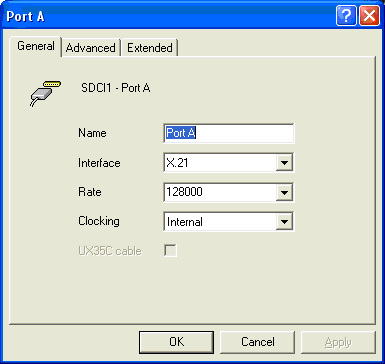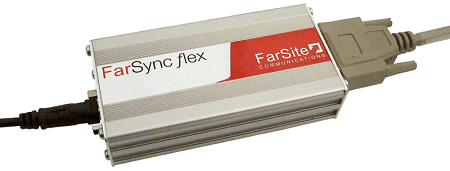|
|
|
Product Name
|
Description
|
Product Code
|
| FarSync Flex
|
1 port synchronous
USB Adapter with Linux and Windows software. This is the base product,
it includes the Flex hardware, USB cable, drivers, utility programs,
documentation on CD-ROM and a quick start guide. |
FS4100 |
| FarSync Flex
SDK |
The Linux and Windows
Developers Toolkit for the FarSync Flex - required if you want to
write software to use the adapters API |
FS9507 |
| FarSync Flex
X25 |
Supports all the features
of the FarSync Flex plus X.25
support, click for details |
FS6100 |
| Cable Options |
| KCR1 |
Cable - RS232C (V.24,
X.21bis) and RS530 (EIA530), same cable for both interfaces, 1.5
metres |
FS6011 |
| UCX1 |
Cable - X.21 (V.11,
RS422), 1.5 metres |
FS6062 |
| UCV1 |
Cable - V.35 with standard
MRAC-34 (brick) male connector, 1.5 metres |
FS6063 |
| KC449 |
Cable - RS449, 1.5
metres |
FS6019 |
 Overview Overview
The FarSync Flex USB adapter is a high quality synchronous solution
for business, government and military applications, it has been developed
to provide high performance, versatile connectivity for Linux and Windows
systems.
The bus powered USB adapter will support a synchronous line at speeds
of up to 2.048 Mbits/s continuous, higher speeds can be supported in
bursts. The highly flexible universal network connector supports
RS232C,
X.21,
RS530, RS449 and
V.35 network interfaces.
The adapter can support the host computer's TCP/IP protocol stack or
an Application can be written to use the low level API for a variety
of different functions.
Features under Linux: The Flex adapter installs seamlessly as
a plug and play device under the popular Linux 32 and 64 bit distributions.
The 2.0 USB adapter supports Linux kernel version 2.6 in 32 and 64 bit
formats, including the leading distributions supplied by Redhat, SuSE,
Mandriva, Debian, Ubuntu, Fedora, Slackware and more. SMP (multi-processor)
systems are supported.
The low level API is based on the raw socket interface supports HDLC
framed and transparent bit stream data.
The Flex adapter can use the TCP/IP stack to allow access to IP based
networks such as the Internet.
FarSite is committed to supporting the FarSync Flex on new versions
of Linux and Linux kernels as they are released. The source code for
the driver is supplied with the product, allowing rebuilding by the
end user for use with almost any of the current or future Linux variants.
Features under Windows: The adapter installs seamlessly as a
plug and play device under Windows XP, Server 2003 and Vista on both
32 and 64 bit, single and multi-core systems.
The low level API is based on the SDCI interface supports HDLC framed
and transparent bit stream data.
The Flex adapter appears as a NDIS (LAN) interface so can simply use
the TCP/IP stack to allow access to IP based networks such as the Internet.
Developers Toolkit: The FarSync Flex SDK provides a Developers
Toolkit with full documentation, useful utilities such as a line monitor
and many sample applications for Linux and Windows.
 Typical Applications Typical Applications
The FarSync Flex adapters are suitable for a very wide range of uses.
Typical applications include:
- Internet Access and remote office access over leased lines
- HDLC framing support for non standard or specialist protocols
- Connection to secure BRENT units
- Interfacing video and voice bitstreams such as T-DMB, DAB and ETI
- Interfacing high speed MPEG Video bitstreams to Servers
- Line monitoring full duplex data
- Data generators for test systems
- Engineering monitoring and control systems
 FarSync
Flex - Product Details FarSync
Flex - Product Details
The FarSync Flex is supplied with support for Windows and Linux. This
includes a low level driver that allows access to the communications
features available in the hardware and an optionally installable driver
that connects with the standard TCP/IP protocol stack to allow access
to IP based networks such as the Internet. Multiple devices can be installed.
 Key Features Key Features
The intelligent FarSync Flex is designed for reliability, high performance
and flexibility. The adapter uses a fast ARM processor with Flash and
RAM for the onboard code.
- Network interfaces for X.21
(V.11, RS422), V.35,
RS232C
(V.24, X.21bis), RS449, RS530
(EIA530)
- Line speeds of up to 2.048 Mbits/s (E1 Speed)
- USB 2.0 high-speed mode (480mb/s) and 1.1 compatible
- Multiple Flex's can be run from a single server
- High efficiency USB Bus powered, energy saving design
- NRZI, NRZ, FM0 and FM1 line signaling formats, tri-state
transmitters and receivers
- Internal and external line clocking
- Dual bank flash for secure in field upgrades and
previous system restore capability
- Software selectable Synchronous HDLC, Transparent
Bitstream and Asynchronous formats
- New releases of the software available for free download
from the Download
page in this web sites Support section
 Key Features
supported on Linux Key Features
supported on Linux
The FarSync Flex installs seamlessly under Linux kernel series 2.6
on both single and multi-core 32 and 64 bit systems. All the popular
distributions are supported including Red Hat, SuSE, Slackware, Ubuntu,
Mandriva, Debian and Fedora.
Installation is simple, the driver is dynamically loadable so a kernel
rebuild is not required for the driver to be installed. The driver acts
as a dynamically loadable module. The link level protocol can be PPP,
Cisco HDLC or Frame Relay with optional authentication by CHAP, MSCHAP
or PAP (RFC 1334) providing a standard point-to-point network interface.
The driver is supplied with source code.
The Raw Sockets API allows applications developed using the FarSync
Flex SDK to access the full feature set of the hardware, these include
bit synchronous (HDLC framed) data, transparent bitstream data, asynchronous
data and signal modes NRZ, NRZI, FM1 and FM0.
A configuration utility is provided to set the line speed, interface
type and protocol, after which the ports may be configured with standard
networking tools.
 Key Features
supported on Windows Key Features
supported on Windows
The FarSync Flex installs easily under Windows Vista, Windows XP, Windows
Server 2003 and Windows 2000 on single or multi-core 32 and 64 bit systems.
A low level SDCI driver is installed with the optional installation
of an NDIS (LAN) driver. The NDIS driver supports TCP/IP running over
PPP with optional authentication by CHAP or PAP (RFC 1334) providing
a standard point-to-point network interface.
The product is supplied with a comprehensive configuration utility
and its own Line Monitor that allows the user to record, display and
store line traffic with WAN protocol decoding for fast debugging. The
Line Monitor application is not suitable for standalone use.
FarSync Flex's enhanced SDCI API allows applications developed using
the FarSync Flex SDK to exactly control the type of data sent and received
in bit synchronous (HDLC framed) data, transparent bitstream formats,
asynchronous data and signal modes NRZ, NRZI, FM1 and FM0.
 FarSync
Flex SDK - The Developers Toolkit FarSync
Flex SDK - The Developers Toolkit
The SDK includes support for writing applications on both Linux and
Windows and contains documentation and working sample applications.
There is everything a user needs to rapidly develop and test a wide
variety of applications such as specialist synchronous (HDLC framed)
protocols or transparent bitstream data requirements including Audio,
MPEG Video T-DMB and DAB ETI. The FarSync Flex SDK is ordered separately.
Windows SDCI API
The SDCI API allows applications to exactly control the type of data
sent and received in both bit synchronous data and transparent bitstream
formats. The SDCI API manual in Adobe PDF format provides a comprehensive
set of function call definitions and helpful advice on the best way
to utilise the interface, the sample applications are written
in C.
Linux Raw Sockets API
The Raw Sockets API allows applications to exactly control the type
of data sent and received in both bit synchronous data and transparent
bitstream formats. The Linux Raw Sockets API manual in Adobe PDF format
provides a comprehensive set of function call
definitions and helpful advice on the best way to utilise the interface.
The sample applications are written in C. Source for the driver is
included.
We provide free email and telephone assistance
to the application developer as part the package provided when
the FarSync Flex SDK is purchased.

 Configuration Configuration
For Windows configuration is by a GUI configuration application, a
typical screen is shown on the right.
The line can be reconfigured and restarted without reloading the software.
There is context sensitive help and an on-line manual should it be
required. An advanced tab permits users to exactly specify the configuration
of the line if necessary.
For Linux a configuration utility is provided, alternatively text files
can be used.
|

 Overview
Overview